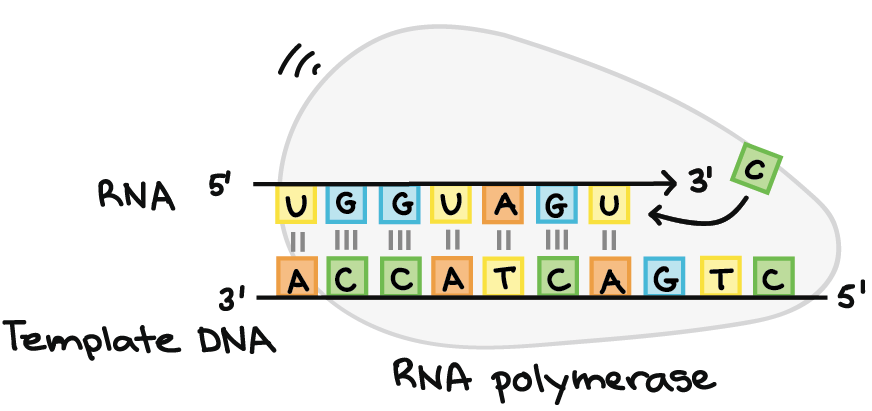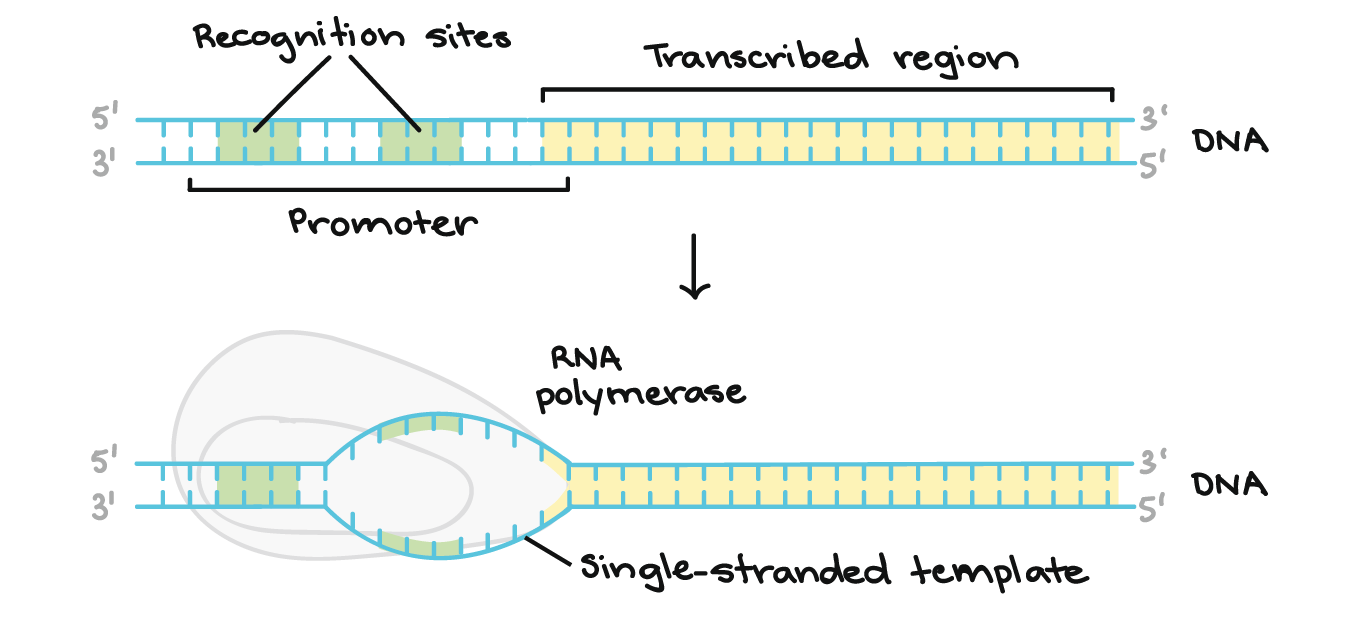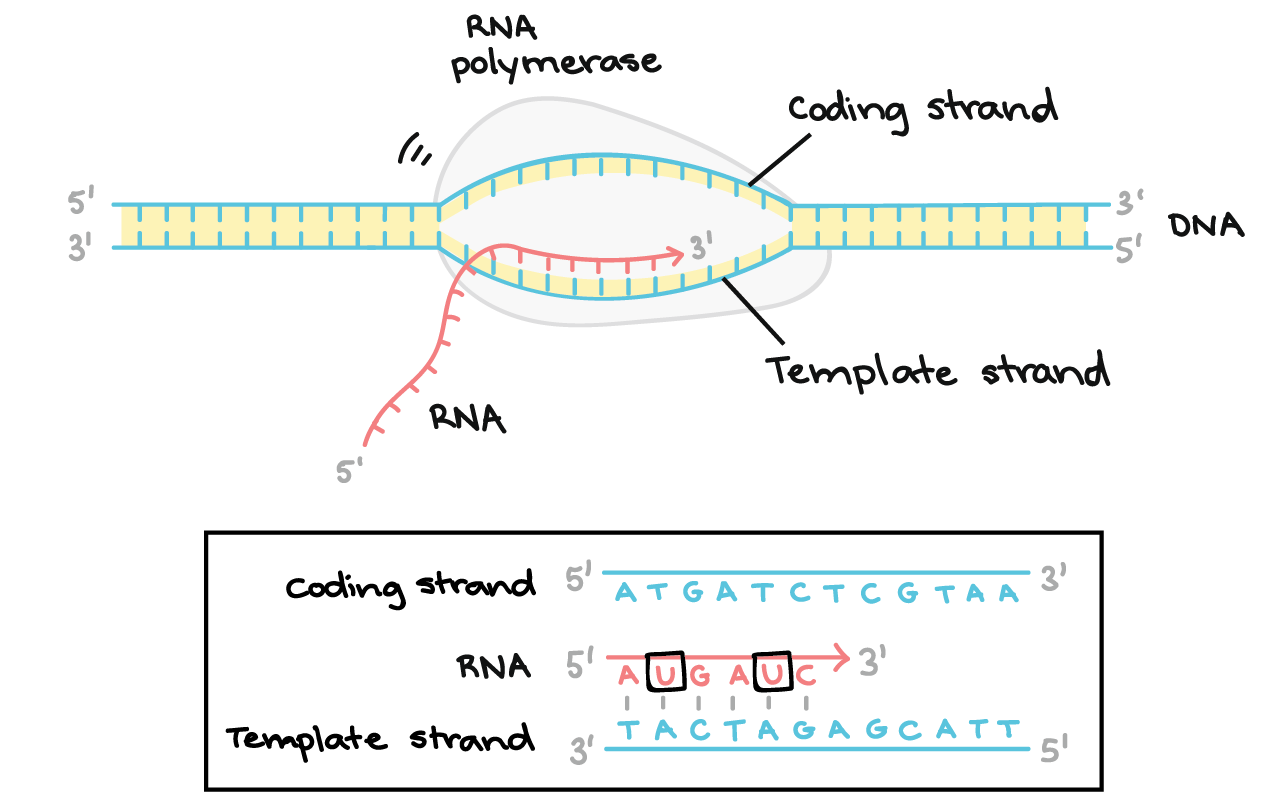10. The central dogma of molecular biology states that the flow of information in cells is from DNA to messenger RNA (mRNA). How does RNA polymerase know where to start transcribing a gene and end it? Explain with a suitable diagram.
10. The central dogma of molecular biology states that the flow of information in cells is from DNA to messenger RNA (mRNA). How does RNA polymerase know where to start transcribing a gene and end it? Explain with a suitable diagram.
answer :
introduction :
Central Dogma:
- A phenomenon in which the genetic information in DNA is converted into a functional product/protein.
- The flow of genetic information is from DNA->RNA->Protein.
- Replication of DNA is defined as copying of the entire genome before the cell divides into two.
- Copying of information from the template DNA molecule onto a new messenger RNA molecule is called transcription.
- The formation of protein molecules after reading of the messenger RNA molecule is called translation.
- For example- a gene sequence on the DNA encoding for color is transcribed into mRNA, which would be further translated into a functional protein that will phenotypically express in flower petals.
Central Dogma:
- A phenomenon in which the genetic information in DNA is converted into a functional product/protein.
- The flow of genetic information is from DNA->RNA->Protein.
- Replication of DNA is defined as copying of the entire genome before the cell divides into two.
- Copying of information from the template DNA molecule onto a new messenger RNA molecule is called transcription.
- The formation of protein molecules after reading of the messenger RNA molecule is called translation.
- For example- a gene sequence on the DNA encoding for color is transcribed into mRNA, which would be further translated into a functional protein that will phenotypically express in flower petals.
RNA polymerase
RNA polymerases are enzymes that transcribe DNA into RNA. Using a DNA template, RNA polymerase builds a new RNA molecule through base pairing. For instance, if there is a G in the DNA template, RNA polymerase will add a C to the new, growing RNA strand.RNA polymerase always builds a new RNA strand in the 5’ to 3’ direction. That is, it can only add RNA nucleotides (A, U, C, or G) to the 3' end of the strand.RNA polymerases are large enzymes with multiple subunits, even in simple organisms like bacteria. Humans and other eukaryotes have three different kinds of RNA polymerase: I, II, and III. Each one specializes in transcribing certain classes of genes. Plants have an additional two kinds of RNA polymerase, IV and V, which are involved in the synthesis of certain small RNAs.
RNA polymerases are enzymes that transcribe DNA into RNA. Using a DNA template, RNA polymerase builds a new RNA molecule through base pairing. For instance, if there is a G in the DNA template, RNA polymerase will add a C to the new, growing RNA strand.
RNA polymerase always builds a new RNA strand in the 5’ to 3’ direction. That is, it can only add RNA nucleotides (A, U, C, or G) to the 3' end of the strand.
RNA polymerases are large enzymes with multiple subunits, even in simple organisms like bacteria. Humans and other eukaryotes have three different kinds of RNA polymerase: I, II, and III. Each one specializes in transcribing certain classes of genes. Plants have an additional two kinds of RNA polymerase, IV and V, which are involved in the synthesis of certain small RNAs.
Transcription initiation
To begin transcribing a gene, RNA polymerase binds to the DNA of the gene at a region called the promoter. Basically, the promoter tells the polymerase where to "sit down" on the DNA and begin transcribing.Each gene (or, in bacteria, each group of genes transcribed together) has its own promoter. A promoter contains DNA sequences that let RNA polymerase or its helper proteins attach to the DNA. Once the transcription bubble has formed, the polymerase can start transcribing.
To begin transcribing a gene, RNA polymerase binds to the DNA of the gene at a region called the promoter. Basically, the promoter tells the polymerase where to "sit down" on the DNA and begin transcribing.
Each gene (or, in bacteria, each group of genes transcribed together) has its own promoter. A promoter contains DNA sequences that let RNA polymerase or its helper proteins attach to the DNA. Once the transcription bubble has formed, the polymerase can start transcribing.
Elongation
Once RNA polymerase is in position at the promoter, the next step of transcription—elongation—can begin. Basically, elongation is the stage when the RNA strand gets longer, thanks to the addition of new nucleotides.During elongation, RNA polymerase "walks" along one strand of DNA, known as the template strand, in the 3' to 5' direction. For each nucleotide in the template, RNA polymerase adds a matching (complementary) RNA nucleotide to the 3' end of the RNA strand.
The RNA transcript is nearly identical to the non-template, or coding, strand of DNA. However, RNA strands have the base uracil (U) in place of thymine (T), as well as a slightly different sugar in the nucleotide. So, as we can see in the diagram above, each T of the coding strand is replaced with a U in the RNA transcript.The picture below shows DNA being transcribed by many RNA polymerases at the same time, each with an RNA "tail" trailing behind it. The polymerases near the start of the gene have short RNA tails, which get longer and longer as the polymerase transcribes more of the gene.
Once RNA polymerase is in position at the promoter, the next step of transcription—elongation—can begin. Basically, elongation is the stage when the RNA strand gets longer, thanks to the addition of new nucleotides.
During elongation, RNA polymerase "walks" along one strand of DNA, known as the template strand, in the 3' to 5' direction. For each nucleotide in the template, RNA polymerase adds a matching (complementary) RNA nucleotide to the 3' end of the RNA strand.
The RNA transcript is nearly identical to the non-template, or coding, strand of DNA. However, RNA strands have the base uracil (U) in place of thymine (T), as well as a slightly different sugar in the nucleotide. So, as we can see in the diagram above, each T of the coding strand is replaced with a U in the RNA transcript.
The picture below shows DNA being transcribed by many RNA polymerases at the same time, each with an RNA "tail" trailing behind it. The polymerases near the start of the gene have short RNA tails, which get longer and longer as the polymerase transcribes more of the gene.
Transcription termination
RNA polymerase will keep transcribing until it gets signals to stop. The process of ending transcription is called termination, and it happens once the polymerase transcribes a sequence of DNA known as a terminator.
RNA polymerase will keep transcribing until it gets signals to stop. The process of ending transcription is called termination, and it happens once the polymerase transcribes a sequence of DNA known as a terminator.
Termination in bacteria
There are two major termination strategies found in bacteria: Rho-dependent and Rho-independent.In Rho-dependent termination, the RNA contains a binding site for a protein called Rho factor. Rho factor binds to this sequence and starts "climbing" up the transcript towards RNA polymerase.When it catches up with the polymerase at the transcription bubble, Rho pulls the RNA transcript and the template DNA strand apart, releasing the RNA molecule and ending transcription. Another sequence found later in the DNA, called the transcription stop point, causes RNA polymerase to pause and thus helps Rho catch up.start superscript, 4, end superscriptRho-independent termination depends on specific sequences in the DNA template strand. As the RNA polymerase approaches the end of the gene being transcribed, it hits a region rich in C and G nucleotides. The RNA transcribed from this region folds back on itself, and the complementary C and G nucleotides bind together. The result is a stable hairpin that causes the polymerase to stall.In a terminator, the hairpin is followed by a stretch of U nucleotides in the RNA, which match up with A nucleotides in the template DNA. The complementary U-A region of the RNA transcript forms only a weak interaction with the template DNA. This, coupled with the stalled polymerase, produces enough instability for the enzyme to fall off and liberate the new RNA transcript.conclusion :After termination, transcription is finished. An RNA transcript that is ready to be used in translation is called a messenger RNA (mRNA). In bacteria, RNA transcripts are ready to be translated right after transcription. In fact, they're actually ready a little sooner than that: translation may start while transcription is still going on!In the diagram below, mRNAs are being transcribed from several different genes. Although transcription is still in progress, ribosomes have attached each mRNA and begun to translate it into protein. When an mRNA is being translated by multiple ribosomes, the mRNA and ribosomes together are said to form a polyribosome.Why can transcription and translation happen simultaneously for an mRNA in bacteria? One reason is that these processes occur in the same 5' to 3' direction. That means one can follow or "chase" another that's still occurring. Also, in bacteria, there are no internal membrane compartments to separate transcription from translation.
There are two major termination strategies found in bacteria: Rho-dependent and Rho-independent.
In Rho-dependent termination, the RNA contains a binding site for a protein called Rho factor. Rho factor binds to this sequence and starts "climbing" up the transcript towards RNA polymerase.
When it catches up with the polymerase at the transcription bubble, Rho pulls the RNA transcript and the template DNA strand apart, releasing the RNA molecule and ending transcription. Another sequence found later in the DNA, called the transcription stop point, causes RNA polymerase to pause and thus helps Rho catch up.start superscript, 4, end superscript
Rho-independent termination depends on specific sequences in the DNA template strand. As the RNA polymerase approaches the end of the gene being transcribed, it hits a region rich in C and G nucleotides. The RNA transcribed from this region folds back on itself, and the complementary C and G nucleotides bind together. The result is a stable hairpin that causes the polymerase to stall.
In a terminator, the hairpin is followed by a stretch of U nucleotides in the RNA, which match up with A nucleotides in the template DNA. The complementary U-A region of the RNA transcript forms only a weak interaction with the template DNA. This, coupled with the stalled polymerase, produces enough instability for the enzyme to fall off and liberate the new RNA transcript.
conclusion :
After termination, transcription is finished. An RNA transcript that is ready to be used in translation is called a messenger RNA (mRNA). In bacteria, RNA transcripts are ready to be translated right after transcription. In fact, they're actually ready a little sooner than that: translation may start while transcription is still going on!
In the diagram below, mRNAs are being transcribed from several different genes. Although transcription is still in progress, ribosomes have attached each mRNA and begun to translate it into protein. When an mRNA is being translated by multiple ribosomes, the mRNA and ribosomes together are said to form a polyribosome.
Why can transcription and translation happen simultaneously for an mRNA in bacteria? One reason is that these processes occur in the same 5' to 3' direction. That means one can follow or "chase" another that's still occurring. Also, in bacteria, there are no internal membrane compartments to separate transcription from translation.







Comments
Post a Comment